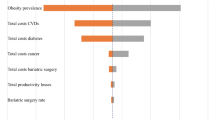Abstract
This study estimated the economic burden of illness of obesity and selected comorbidities in terms of health outcome and costs to society and healthcare payer in Germany. The proportions of selected diseases (comorbidities) attributable solely to obesity were estimated using odds ratios/relative risks and prevalences based on data from the literature. The top-down approach was employed to match healthcare spending with the number of patients suffering from obesity (BMI 30+) and the major comorbidities to evaluate overall direct and indirect costs. In Germany there are approximately 12.24 million obese adults, 2.06–3.76 million of whom suffer from the selected comorbidities. From a societal perspective the total costs for obesity and comorbidities are €2,701–5,682 million per year and the direct treatment costs alone account for €1,343–2,699 million, imposing a major burden to the healthcare system. In view of the magnitude of the economic burden of illness there is a need for both further research and action at the health policy level.



Similar content being viewed by others
References
Anonymous (1998) Clinical guidelines on the identification, evaluation, and treatment of overweight and obesity in adults—the evidence report. National Institutes of Health. Obes Res 6 [Suppl 2]:51S–209S
Anonymous (1998) Gesundheitsbericht für Deutschland: Gesundheitsberichterstattung des Bundes/Statistisches Bundesamt. Statistisches Bundesamt. Metzler-Poeschel: Stuttgart
Bergmann KE, Mensink GB (1999) [Anthropometric data and obesity]. Gesundheitswesen 61 [Suppl]:S115–S120
Colditz GA, Willett WC, Rotnitzky A, Manson JE (1995) Weight gain as a risk factor for clinical diabetes mellitus in women. Ann Intern Med 122:481–486
Deutsche Adipositas Gesellschaft (2002) Richtlinien zur Therapie der Adipositas. Deutsche Adipositas Gesellschaft
Hoffmeister H, Horch K (1993) Welche Relevanz hat das Übergewicht für die Gesundheit? Adipositas 5:8–11
Kohlmeier L, Kroke A, Pötzsch J, Kohlmeier M, Martin K (1993) Ernährungsabhängige Krankheiten und ihre Kosten. Nomos: Baden-Baden
Kurscheid T, Lauterbach K (1998) The cost implications of obesity for health care and society. Int J Obes Relat Metab Disord 22 [Suppl 1]:S3–S5
Kübler W (1997) Die nationale Verzehrsstudie (NVS) und die Verbundstudie Ernährungserhebung und Risikofaktoren-Analytik (VERA). VERA-Schriftenreihe, vol XIV. Fleck
Lauterbach K, Westenhöfer J, Wirth A, Hauner H (1998) Adipositas Leitlinie. Evidenz-basierte Leitlinie zur Behandlung der Adipositas in Deutschland.IGKE: Cologne
Manson JE, Colditz GA, Stampfer MJ, Willett WC, Rosner B, Monson RR, et al (1990) A prospective study of obesity and risk of coronary heart disease in women. N Engl J Med 322:882–889
Okosun IS, Chandra KM, Choi S, Christman J, Dever GE, Prewitt TE (2001) Hypertension and type 2 diabetes comorbidity in adults in the United States: risk of overall and regional adiposity. Obes Res 9:1–9
Quesenberry CP Jr, Caan B, Jacobson A (1998) Obesity, health services use, and health care costs among members of a health maintenance organization. Arch Intern Med 158:466–472
Rexrode KM, Hennekens CH, Willett WC, Colditz GA, Stampfer MJ, Rich-Edwards JW, et al (1997) A prospective study of body mass index, weight change, and risk of stroke in women. JAMA 277:1539–1545
Royal College of Physicians (1996) Overweight and obese patients. Principles of management of overweight and obese patients with particular reference to the use of drugs. Royal Coll Physicians
Schneider R (1996) Relevanz und Kosten der Adipositas in Deutschland. Ernährungs-Umschau 43:369–374
Scottish Intercollegiate Guidelines Network (1996) Obesity in Scotland. Integrating prevention with weight management. A national guideline recommended for use in Scotland. SIGN
Seidell JC (1995) The impact of obesity on health status: some implications for health care costs. Int J Obes Relat Metab Disord 19 [Suppl 6]:S13–S16
Statistisches Bundesamt Deutschland (2002) Neue Gesundheitsausgabenrechnung: Gesundheitsausgaben nach Leistungsarten in Mill. EUR. Online Services: 28 May, 21 November
Statistisches Bundesamt Deutschland (2002) Preisindex für die Lebenshaltung (consumer price index). Online Services 27 June
Van Itallie TB (1985) Health implications of overweight and obesity in the United States. Ann Intern Med 103:983–988
Wendland G, Kurscheid T, Lauterbach K (1999) Gesundheitsökonomie und Lebensqualität der S.A.T.-Studie
Willett WC, Manson JE, Stampfer MJ, Colditz GA, Rosner B, Speizer FE, et al (1995) Weight, weight change, and coronary heart disease in women. Risk within the 'normal' weight range. JAMA 273:461–465
Wolf AM, Colditz GA (1998) Current estimates of the economic cost of obesity in the United States. Obes Res 6:97–106
Acknowledgements
We thank Anja Hommel, MSc, and Jens P. Diedrich, PhD, for their contribution to a former version of the manuscript. We are also grateful to Elvira Müller, PhD, for her intellectual contribution and critical reading of the manuscript.
Author information
Authors and Affiliations
Corresponding author
Additional information
Financial support for this study was provided entirely by a contract with Abbott GmbH & Co KG, Center for Pharmaceutical Appraisal & Outcomes Research. The funding agreement ensured the authors' independence in designing the study, interpreting the data, writing, and publishing the report.
Appendix: calculation of exposure-dependent prevalence
Appendix: calculation of exposure-dependent prevalence
Given:
-
T fields N, e, f, g, h in Table 5
Table 5. Calculation of exposure-dependent prevalence -
Odds ratio (OR)
Only one of the fields a, b, c, or d needs to be calculated to estimate all the others:
Equation 1 needs to be substituted to estimate a:
Substitution of Eq. 1 with Eqs. 2, 3, and 4 leads to:
Rearranging:
→ quadratic equation: x 2+px+q=0 where:
→ solution to quadratic equation: \( x = - {\textstyle{p \over 2}} \pm \sqrt {{\textstyle{{p^2 } \over 4}} - q} \)→ substitute with Eqs. 5, 6, and 7:
The attributable proportion in the population (AP pop ) is then calculated by:
Rights and permissions
About this article
Cite this article
Sander, B., Bergemann, R. Economic burden of obesity and its complications in Germany. HEPAC 4, 248–253 (2003). https://doi.org/10.1007/s10198-003-0178-1
Issue Date:
DOI: https://doi.org/10.1007/s10198-003-0178-1




